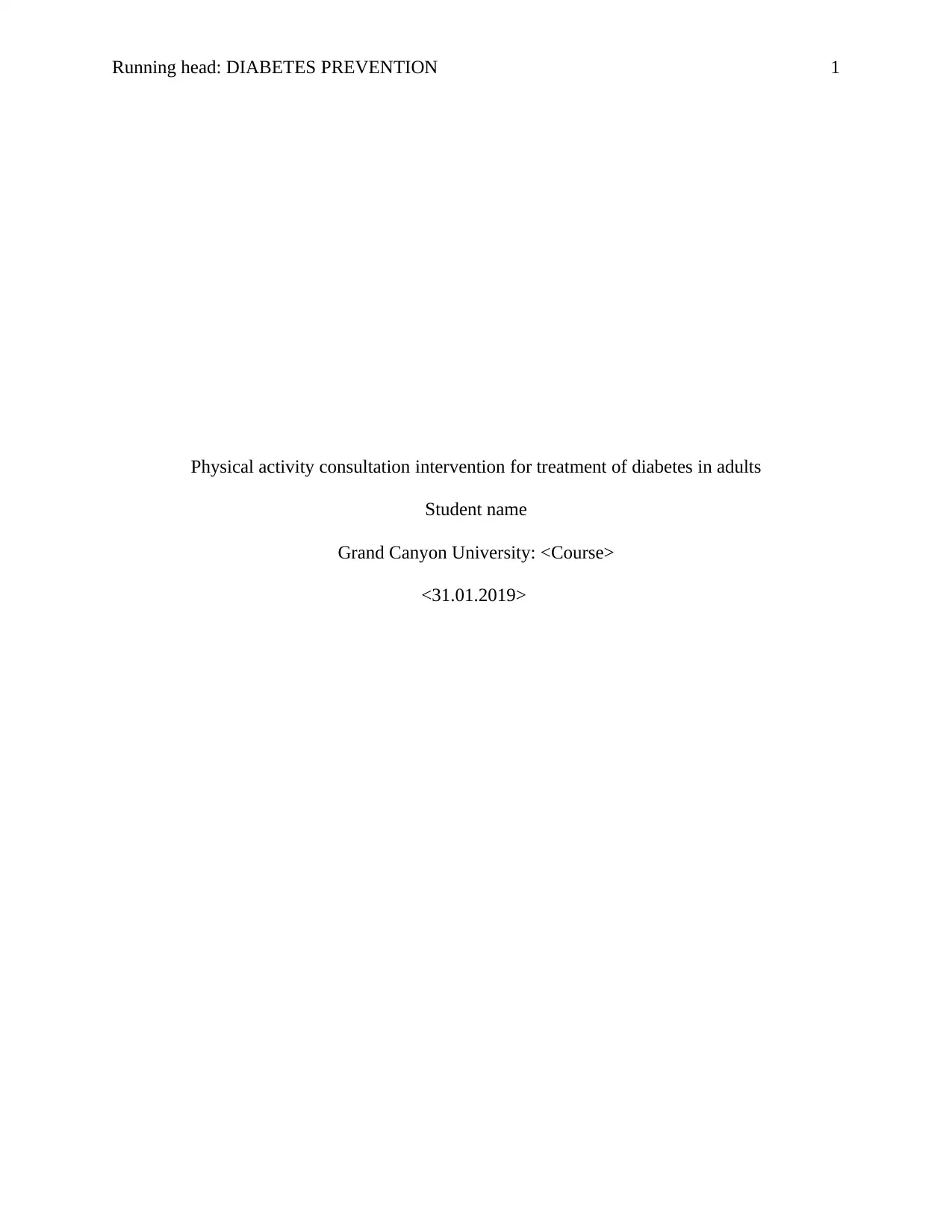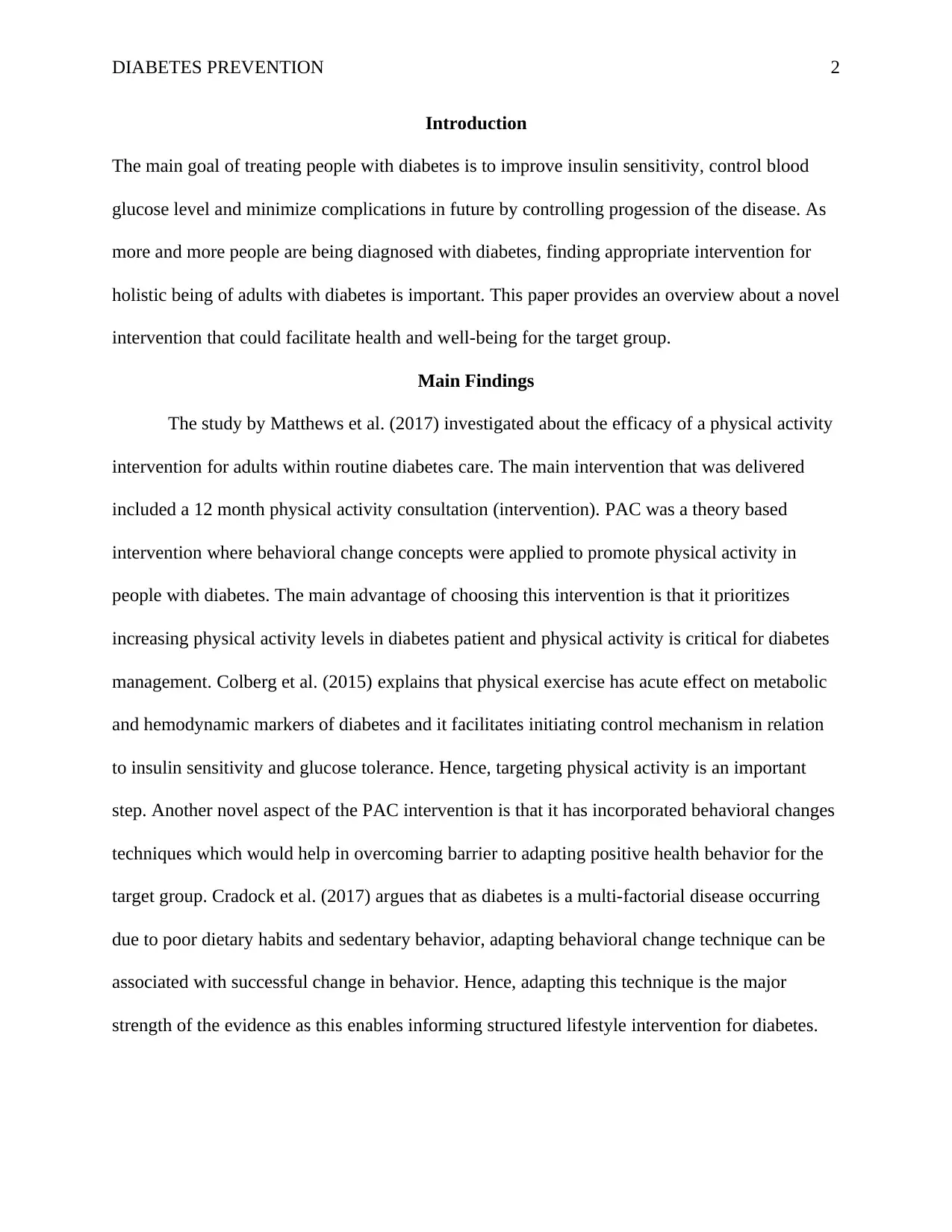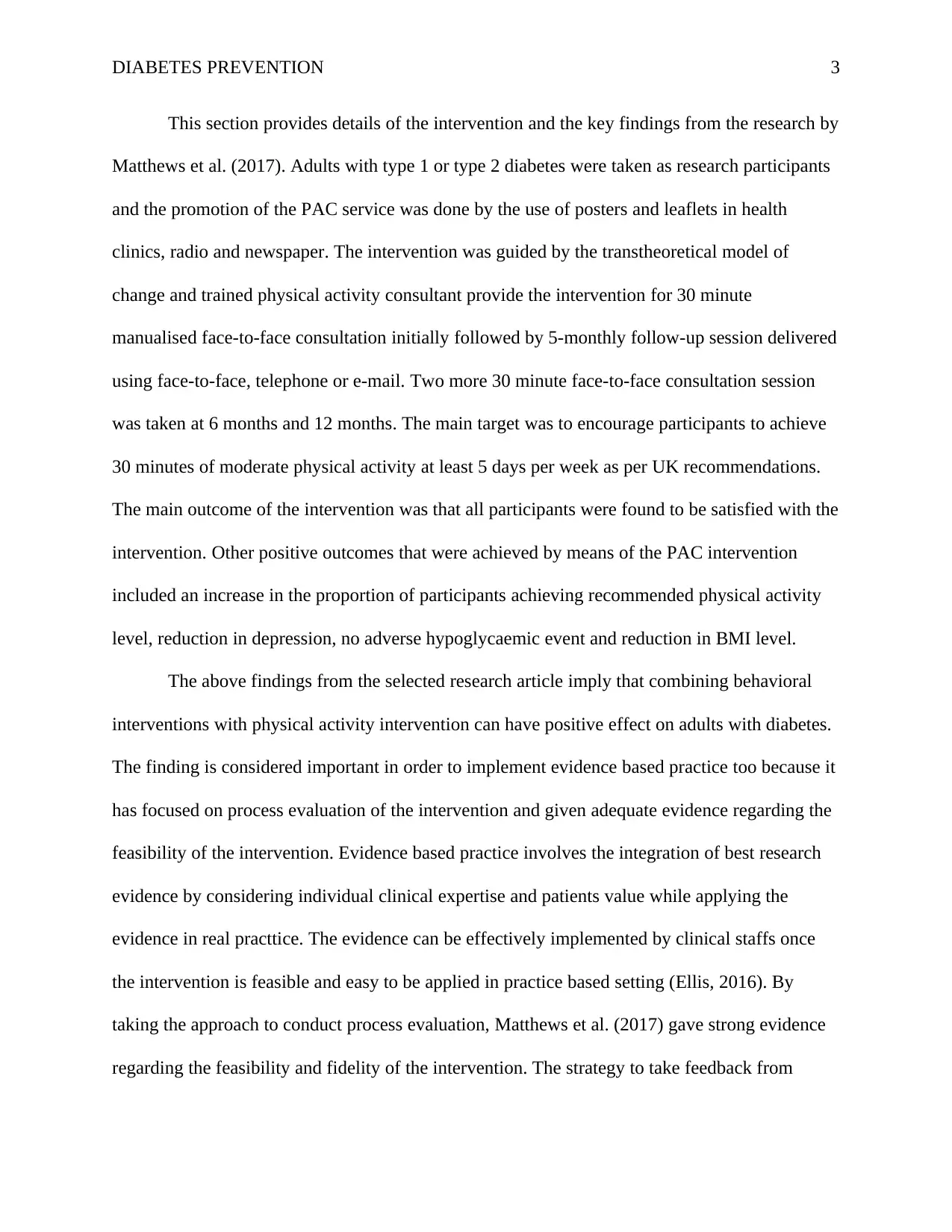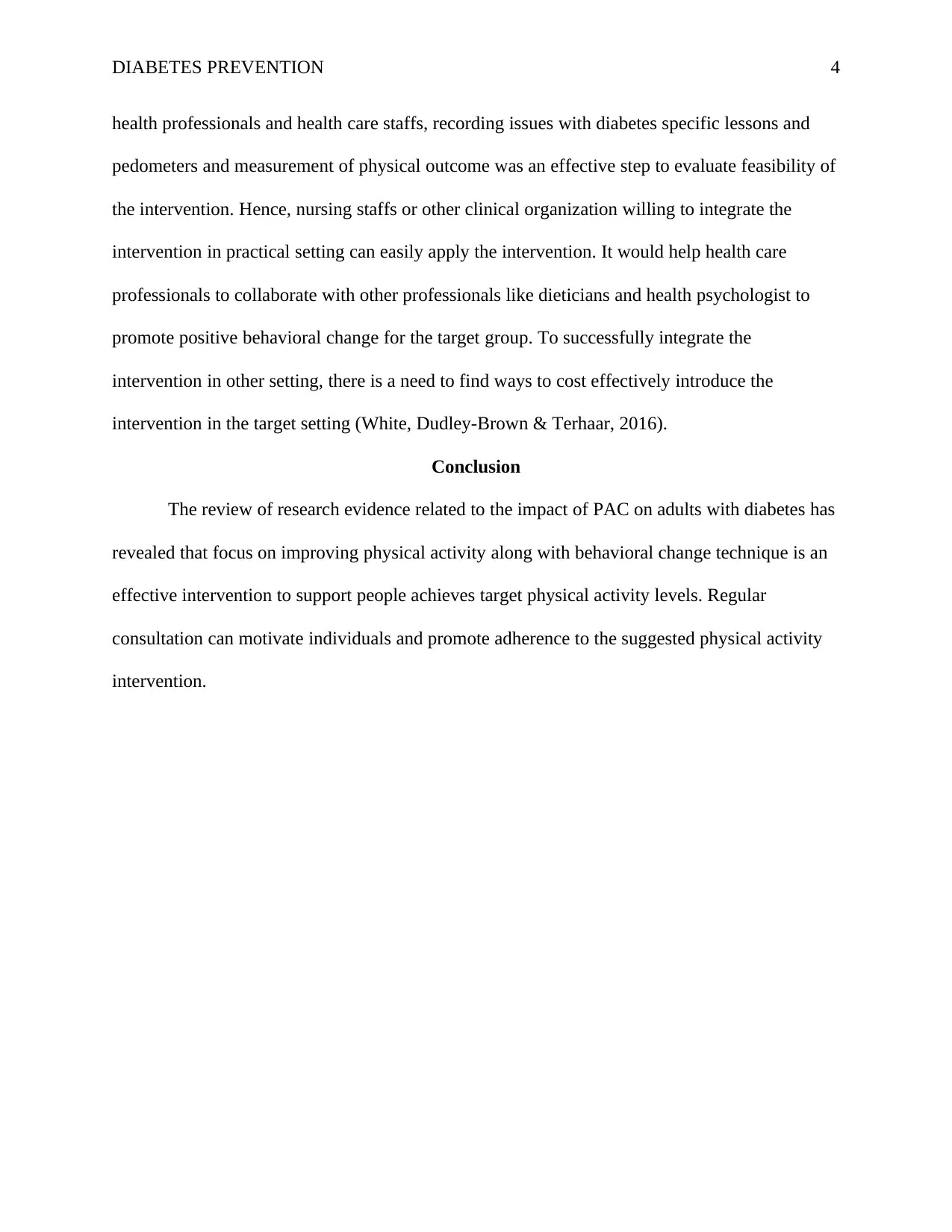Physical Activity Consultation Intervention for Diabetes GCU Course
VerifiedAdded on 2023/06/03
|6
|1161
|232
Report
AI Summary
This report examines the effectiveness of a physical activity consultation (PAC) intervention for adults with diabetes, focusing on improving insulin sensitivity and controlling blood glucose levels. The intervention, guided by the transtheoretical model of change, involves trained consultants providing face-to-face consultations and follow-up sessions to encourage participants to achieve recommended physical activity levels. Key findings from a study by Matthews et al. (2017) indicate that participants were satisfied with the intervention, leading to increased physical activity, reduced depression, and lower BMI. The report emphasizes the importance of integrating behavioral change techniques with physical activity to promote positive health behaviors and discusses the feasibility of implementing the intervention in clinical settings, highlighting the need for cost-effective strategies and collaboration among healthcare professionals. The conclusion supports the use of regular consultation to motivate individuals and promote adherence to physical activity interventions for diabetes management.

Running head: DIABETES PREVENTION
Physical activity consultation intervention for treatment of diabetes in adults
Student name
Grand Canyon University: <Course>
<31.01.2019>
1
Physical activity consultation intervention for treatment of diabetes in adults
Student name
Grand Canyon University: <Course>
<31.01.2019>
1
Paraphrase This Document
Need a fresh take? Get an instant paraphrase of this document with our AI Paraphraser

DIABETES PREVENTION
Introduction
The main goal of treating people with diabetes is to improve insulin sensitivity, control blood
glucose level and minimize complications in future by controlling progession of the disease. As
more and more people are being diagnosed with diabetes, finding appropriate intervention for
holistic being of adults with diabetes is important. This paper provides an overview about a novel
intervention that could facilitate health and well-being for the target group.
Main Findings
The study by Matthews et al. (2017) investigated about the efficacy of a physical activity
intervention for adults within routine diabetes care. The main intervention that was delivered
included a 12 month physical activity consultation (intervention). PAC was a theory based
intervention where behavioral change concepts were applied to promote physical activity in
people with diabetes. The main advantage of choosing this intervention is that it prioritizes
increasing physical activity levels in diabetes patient and physical activity is critical for diabetes
management. Colberg et al. (2015) explains that physical exercise has acute effect on metabolic
and hemodynamic markers of diabetes and it facilitates initiating control mechanism in relation
to insulin sensitivity and glucose tolerance. Hence, targeting physical activity is an important
step. Another novel aspect of the PAC intervention is that it has incorporated behavioral changes
techniques which would help in overcoming barrier to adapting positive health behavior for the
target group. Cradock et al. (2017) argues that as diabetes is a multi-factorial disease occurring
due to poor dietary habits and sedentary behavior, adapting behavioral change technique can be
associated with successful change in behavior. Hence, adapting this technique is the major
strength of the evidence as this enables informing structured lifestyle intervention for diabetes.
2
Introduction
The main goal of treating people with diabetes is to improve insulin sensitivity, control blood
glucose level and minimize complications in future by controlling progession of the disease. As
more and more people are being diagnosed with diabetes, finding appropriate intervention for
holistic being of adults with diabetes is important. This paper provides an overview about a novel
intervention that could facilitate health and well-being for the target group.
Main Findings
The study by Matthews et al. (2017) investigated about the efficacy of a physical activity
intervention for adults within routine diabetes care. The main intervention that was delivered
included a 12 month physical activity consultation (intervention). PAC was a theory based
intervention where behavioral change concepts were applied to promote physical activity in
people with diabetes. The main advantage of choosing this intervention is that it prioritizes
increasing physical activity levels in diabetes patient and physical activity is critical for diabetes
management. Colberg et al. (2015) explains that physical exercise has acute effect on metabolic
and hemodynamic markers of diabetes and it facilitates initiating control mechanism in relation
to insulin sensitivity and glucose tolerance. Hence, targeting physical activity is an important
step. Another novel aspect of the PAC intervention is that it has incorporated behavioral changes
techniques which would help in overcoming barrier to adapting positive health behavior for the
target group. Cradock et al. (2017) argues that as diabetes is a multi-factorial disease occurring
due to poor dietary habits and sedentary behavior, adapting behavioral change technique can be
associated with successful change in behavior. Hence, adapting this technique is the major
strength of the evidence as this enables informing structured lifestyle intervention for diabetes.
2

DIABETES PREVENTION
This section provides details of the intervention and the key findings from the research by
Matthews et al. (2017). Adults with type 1 or type 2 diabetes were taken as research participants
and the promotion of the PAC service was done by the use of posters and leaflets in health
clinics, radio and newspaper. The intervention was guided by the transtheoretical model of
change and trained physical activity consultant provide the intervention for 30 minute
manualised face-to-face consultation initially followed by 5-monthly follow-up session delivered
using face-to-face, telephone or e-mail. Two more 30 minute face-to-face consultation session
was taken at 6 months and 12 months. The main target was to encourage participants to achieve
30 minutes of moderate physical activity at least 5 days per week as per UK recommendations.
The main outcome of the intervention was that all participants were found to be satisfied with the
intervention. Other positive outcomes that were achieved by means of the PAC intervention
included an increase in the proportion of participants achieving recommended physical activity
level, reduction in depression, no adverse hypoglycaemic event and reduction in BMI level.
The above findings from the selected research article imply that combining behavioral
interventions with physical activity intervention can have positive effect on adults with diabetes.
The finding is considered important in order to implement evidence based practice too because it
has focused on process evaluation of the intervention and given adequate evidence regarding the
feasibility of the intervention. Evidence based practice involves the integration of best research
evidence by considering individual clinical expertise and patients value while applying the
evidence in real practtice. The evidence can be effectively implemented by clinical staffs once
the intervention is feasible and easy to be applied in practice based setting (Ellis, 2016). By
taking the approach to conduct process evaluation, Matthews et al. (2017) gave strong evidence
regarding the feasibility and fidelity of the intervention. The strategy to take feedback from
3
This section provides details of the intervention and the key findings from the research by
Matthews et al. (2017). Adults with type 1 or type 2 diabetes were taken as research participants
and the promotion of the PAC service was done by the use of posters and leaflets in health
clinics, radio and newspaper. The intervention was guided by the transtheoretical model of
change and trained physical activity consultant provide the intervention for 30 minute
manualised face-to-face consultation initially followed by 5-monthly follow-up session delivered
using face-to-face, telephone or e-mail. Two more 30 minute face-to-face consultation session
was taken at 6 months and 12 months. The main target was to encourage participants to achieve
30 minutes of moderate physical activity at least 5 days per week as per UK recommendations.
The main outcome of the intervention was that all participants were found to be satisfied with the
intervention. Other positive outcomes that were achieved by means of the PAC intervention
included an increase in the proportion of participants achieving recommended physical activity
level, reduction in depression, no adverse hypoglycaemic event and reduction in BMI level.
The above findings from the selected research article imply that combining behavioral
interventions with physical activity intervention can have positive effect on adults with diabetes.
The finding is considered important in order to implement evidence based practice too because it
has focused on process evaluation of the intervention and given adequate evidence regarding the
feasibility of the intervention. Evidence based practice involves the integration of best research
evidence by considering individual clinical expertise and patients value while applying the
evidence in real practtice. The evidence can be effectively implemented by clinical staffs once
the intervention is feasible and easy to be applied in practice based setting (Ellis, 2016). By
taking the approach to conduct process evaluation, Matthews et al. (2017) gave strong evidence
regarding the feasibility and fidelity of the intervention. The strategy to take feedback from
3
⊘ This is a preview!⊘
Do you want full access?
Subscribe today to unlock all pages.

Trusted by 1+ million students worldwide

DIABETES PREVENTION
health professionals and health care staffs, recording issues with diabetes specific lessons and
pedometers and measurement of physical outcome was an effective step to evaluate feasibility of
the intervention. Hence, nursing staffs or other clinical organization willing to integrate the
intervention in practical setting can easily apply the intervention. It would help health care
professionals to collaborate with other professionals like dieticians and health psychologist to
promote positive behavioral change for the target group. To successfully integrate the
intervention in other setting, there is a need to find ways to cost effectively introduce the
intervention in the target setting (White, Dudley-Brown & Terhaar, 2016).
Conclusion
The review of research evidence related to the impact of PAC on adults with diabetes has
revealed that focus on improving physical activity along with behavioral change technique is an
effective intervention to support people achieves target physical activity levels. Regular
consultation can motivate individuals and promote adherence to the suggested physical activity
intervention.
4
health professionals and health care staffs, recording issues with diabetes specific lessons and
pedometers and measurement of physical outcome was an effective step to evaluate feasibility of
the intervention. Hence, nursing staffs or other clinical organization willing to integrate the
intervention in practical setting can easily apply the intervention. It would help health care
professionals to collaborate with other professionals like dieticians and health psychologist to
promote positive behavioral change for the target group. To successfully integrate the
intervention in other setting, there is a need to find ways to cost effectively introduce the
intervention in the target setting (White, Dudley-Brown & Terhaar, 2016).
Conclusion
The review of research evidence related to the impact of PAC on adults with diabetes has
revealed that focus on improving physical activity along with behavioral change technique is an
effective intervention to support people achieves target physical activity levels. Regular
consultation can motivate individuals and promote adherence to the suggested physical activity
intervention.
4
Paraphrase This Document
Need a fresh take? Get an instant paraphrase of this document with our AI Paraphraser

DIABETES PREVENTION
References
Colberg, S. R., Laan, R., Dassau, E., & Kerr, D. (2015). Physical activity and type 1 diabetes:
time for a rewire?. Journal of diabetes science and technology, 9(3), 609-618. DOI:
10.4239/wjd.v5.i5.659
Cradock, K.A., ÓLaighin, G., Finucane, F.M., Gainforth, H.L., Quinlan, L.R. and Ginis, K.A.M.,
2017. Behaviour change techniques targeting both diet and physical activity in type 2
diabetes: A systematic review and meta-analysis. International Journal of Behavioral
Nutrition and Physical Activity, 14(1), p.18. https://doi.org/10.1186/s12966-016-0436-0
Ellis, P., 2016. Evidence-based practice in nursing. Learning Matters. Retrieved from:
https://books.google.co.in/books?
hl=en&lr=&id=6BUFDAAAQBAJ&oi=fnd&pg=PP1&dq=Ellis,+P.,+2016.+Evidence-
based+practice+in+nursing.
+Learning+Matters.&ots=s1h23Cqghq&sig=9MlE3JNz_T_rqNM_a7HPbjxx9UI#v=one
page&q=Ellis%2C%20P.%2C%202016.%20Evidence-based%20practice%20in
%20nursing.%20Learning%20Matters.&f=false
Matthews, L., Kirk, A., McCallum, M., Mutrie, N., Gold, A., & Keen, A. (2017). The feasibility
of a physical activity intervention for adults within routine diabetes care: A process
evaluation. Practical Diabetes, 34(1), 7-12a. Retrieved from:
https://www.practicaldiabetes.com/wp-content/uploads/sites/29/2017/01/OA-Kirk-
lsw.pdf
White, K. M., Dudley-Brown, S., & Terhaar, M. F. (Eds.). (2016). Translation of evidence into
nursing and health care. Springer Publishing Company. Retrieved from:
http://lghttp.48653.nexcesscdn.net/80223CF/springer-static/media/samplechapters/
9780826106155/9780826106155_chapter.pdf
5
References
Colberg, S. R., Laan, R., Dassau, E., & Kerr, D. (2015). Physical activity and type 1 diabetes:
time for a rewire?. Journal of diabetes science and technology, 9(3), 609-618. DOI:
10.4239/wjd.v5.i5.659
Cradock, K.A., ÓLaighin, G., Finucane, F.M., Gainforth, H.L., Quinlan, L.R. and Ginis, K.A.M.,
2017. Behaviour change techniques targeting both diet and physical activity in type 2
diabetes: A systematic review and meta-analysis. International Journal of Behavioral
Nutrition and Physical Activity, 14(1), p.18. https://doi.org/10.1186/s12966-016-0436-0
Ellis, P., 2016. Evidence-based practice in nursing. Learning Matters. Retrieved from:
https://books.google.co.in/books?
hl=en&lr=&id=6BUFDAAAQBAJ&oi=fnd&pg=PP1&dq=Ellis,+P.,+2016.+Evidence-
based+practice+in+nursing.
+Learning+Matters.&ots=s1h23Cqghq&sig=9MlE3JNz_T_rqNM_a7HPbjxx9UI#v=one
page&q=Ellis%2C%20P.%2C%202016.%20Evidence-based%20practice%20in
%20nursing.%20Learning%20Matters.&f=false
Matthews, L., Kirk, A., McCallum, M., Mutrie, N., Gold, A., & Keen, A. (2017). The feasibility
of a physical activity intervention for adults within routine diabetes care: A process
evaluation. Practical Diabetes, 34(1), 7-12a. Retrieved from:
https://www.practicaldiabetes.com/wp-content/uploads/sites/29/2017/01/OA-Kirk-
lsw.pdf
White, K. M., Dudley-Brown, S., & Terhaar, M. F. (Eds.). (2016). Translation of evidence into
nursing and health care. Springer Publishing Company. Retrieved from:
http://lghttp.48653.nexcesscdn.net/80223CF/springer-static/media/samplechapters/
9780826106155/9780826106155_chapter.pdf
5

DIABETES PREVENTION 6
⊘ This is a preview!⊘
Do you want full access?
Subscribe today to unlock all pages.

Trusted by 1+ million students worldwide
1 out of 6
Related Documents
Your All-in-One AI-Powered Toolkit for Academic Success.
+13062052269
info@desklib.com
Available 24*7 on WhatsApp / Email
![[object Object]](/_next/static/media/star-bottom.7253800d.svg)
Unlock your academic potential
Copyright © 2020–2025 A2Z Services. All Rights Reserved. Developed and managed by ZUCOL.





